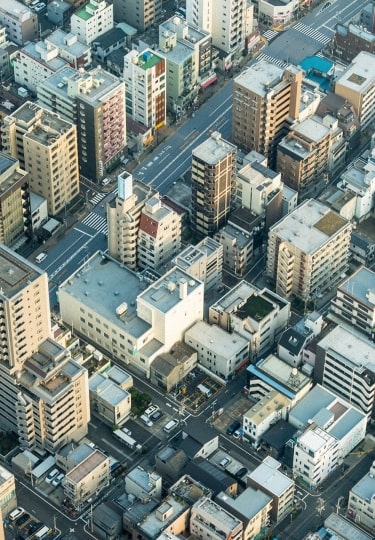Home to more than 37 million people, and constantly changing, Tokyo sprawls over a vast area. As in any big city, the best way to explore it is to focus on its neighborhoods, each of which has its own unique identity.
Whether you’re looking for world-class shopping, high-octane glamor, traditional temples or the freshest sushi imaginable, Tokyo will not disappoint—and there’s something new to discover every time you visit.
Discover some of the very best neighborhoods in Tokyo with this guide.
Asakusa: Tea & Temples
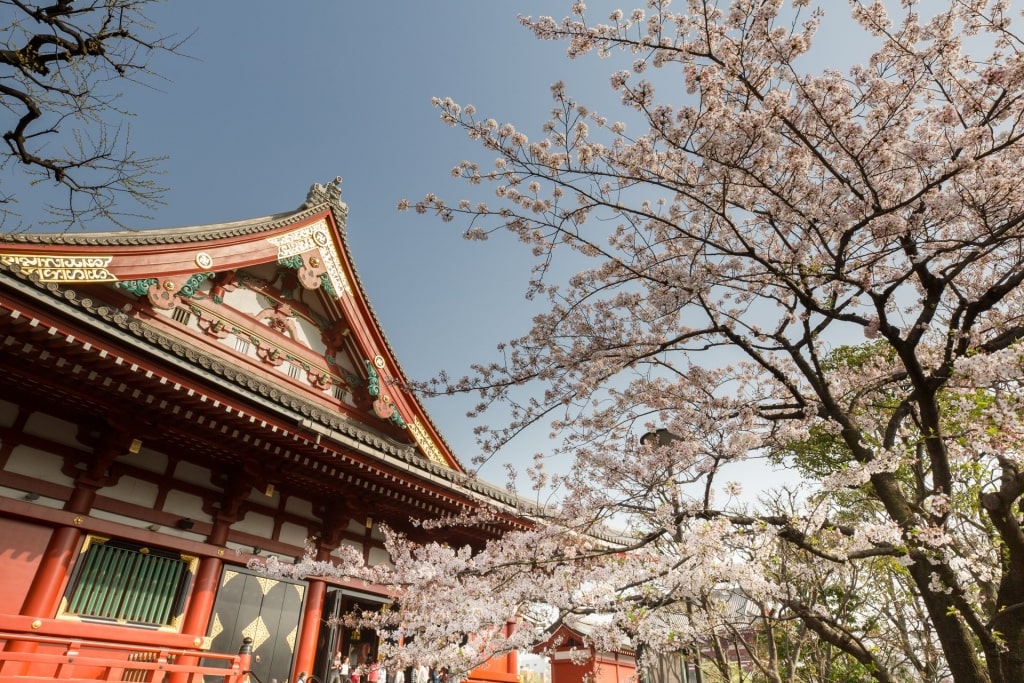
Sensoji Temple, Asakusa
Asakusa is a neighborhood that can still transport you back to the Tokyo of centuries past. Its original character of small curving alleyways lined with flowerpots, one-story houses and stray cats is known as shitamachi (“low city”) and Asakusa is the epicenter.
At the physical and metaphorical heart of the neighborhood is Sensoji, the oldest temple (“ji”) and a popular landmark in Japan. Dating back 1,400 years, it was destroyed during World War II but lovingly rebuilt as a symbol of peace for modern Japan.
Starting at Sensoji’s Kaminarimon (“Thunder Gate”) is the famous shopping street of Nakamise. Once the place for temple visitors to buy food and other offerings, you’ll find it also sells wonderful arts and crafts souvenirs.
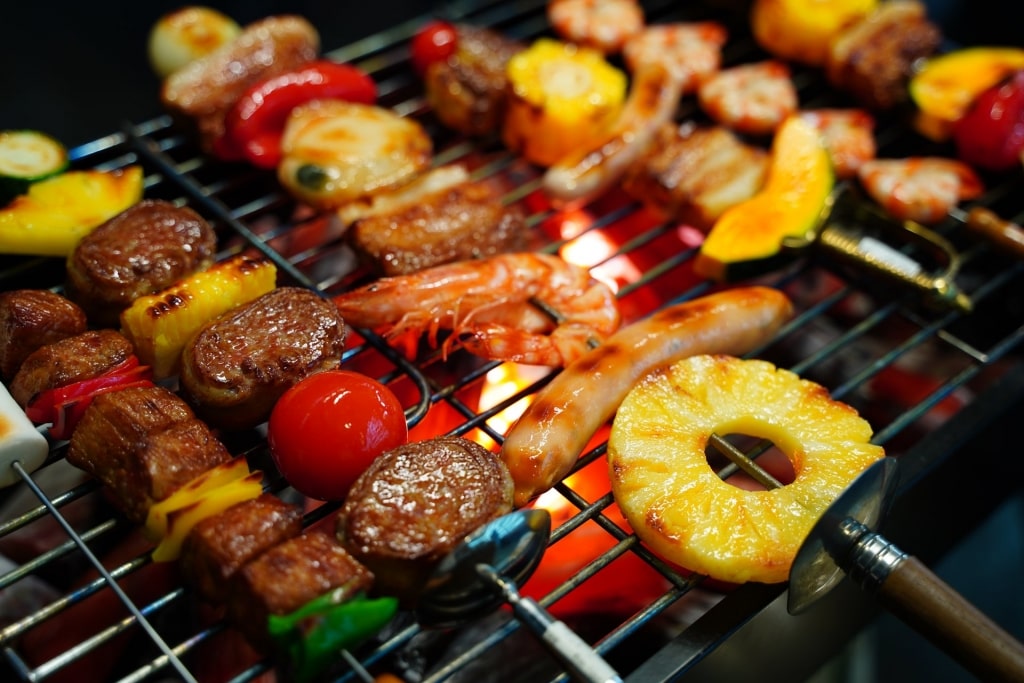
Kappabashi Shopping Street, Asakusa
Equally artistic finds of a different sort can be discovered along Kappabashi Shopping Street, heart of the restaurant supply business. Sharpen your sashimi or sushi skills with new kitchen knives, buy exquisite Japanese porcelain or have fun with the realistic plastic or wax food samples local restaurants use to show off their menus.
Asakusa is also where to look for a vintage kimono store, shops selling the greenest of green tea or a shopping arcade looking unchanged from the early 1900s.
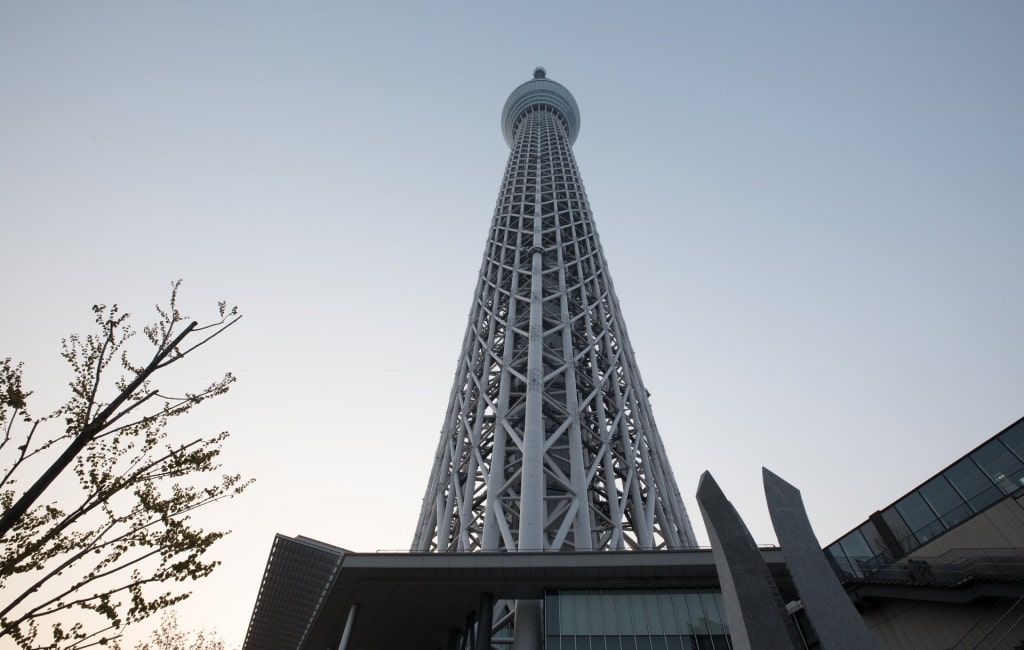
Tokyo Skytree, Asakusa
In contrast, the Tokyo Skytree is a 2,080-foot tower with views as far as Mount Fuji. See it from the lovely grounds of Sumida Park or on a cruise along the Sumida River, Tokyo’s gateway to the sea.
Ginza: Luxury & Shopping
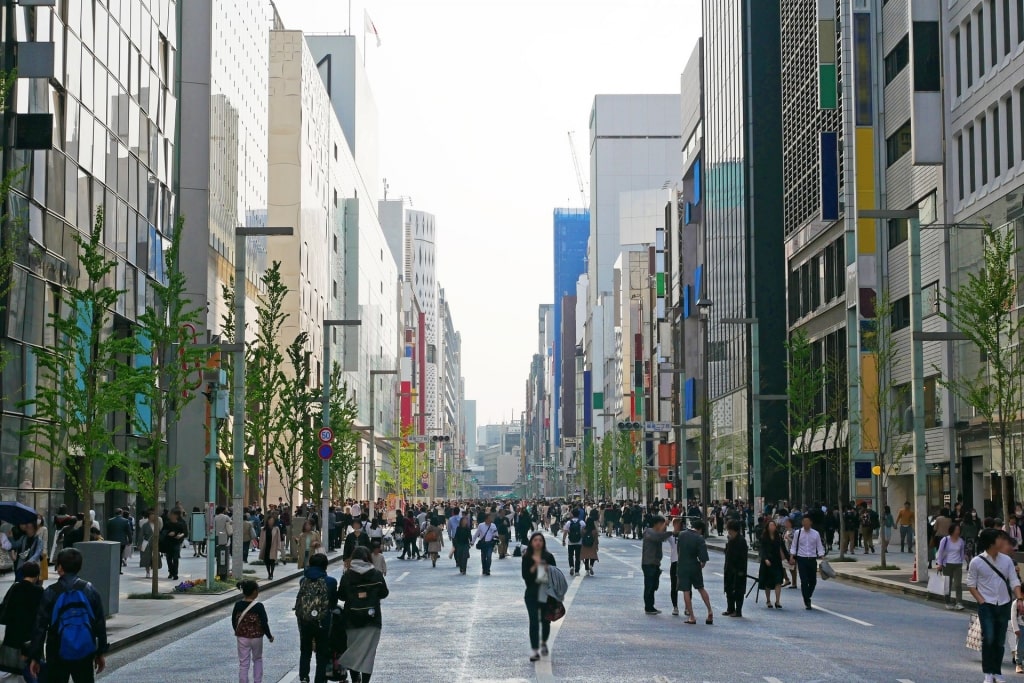
Ginza
Tokyo is famed for its shopping, fashion, and markets, and Ginza is one of its top destinations. Ginza’s name comes from a former Edo Period silver mint and although that is long gone, making money remains a central preoccupation—as does spending it in glorious ways.
You’ll find luxury stores, high fashion, art galleries, fine dining and nightclubs in this Tokyo neighborhood, while the landmark Ginza Wako clock tower pays tribute to the district’s long tradition of watchmaking.
A fire in 1872 and an earthquake in 1923 allowed the neighborhood to be rebuilt in a more modern style than the rest of Tokyo, with broad, European-style avenues linked by more traditional side streets. It now boasts some of the most expensive real estate in Japan.
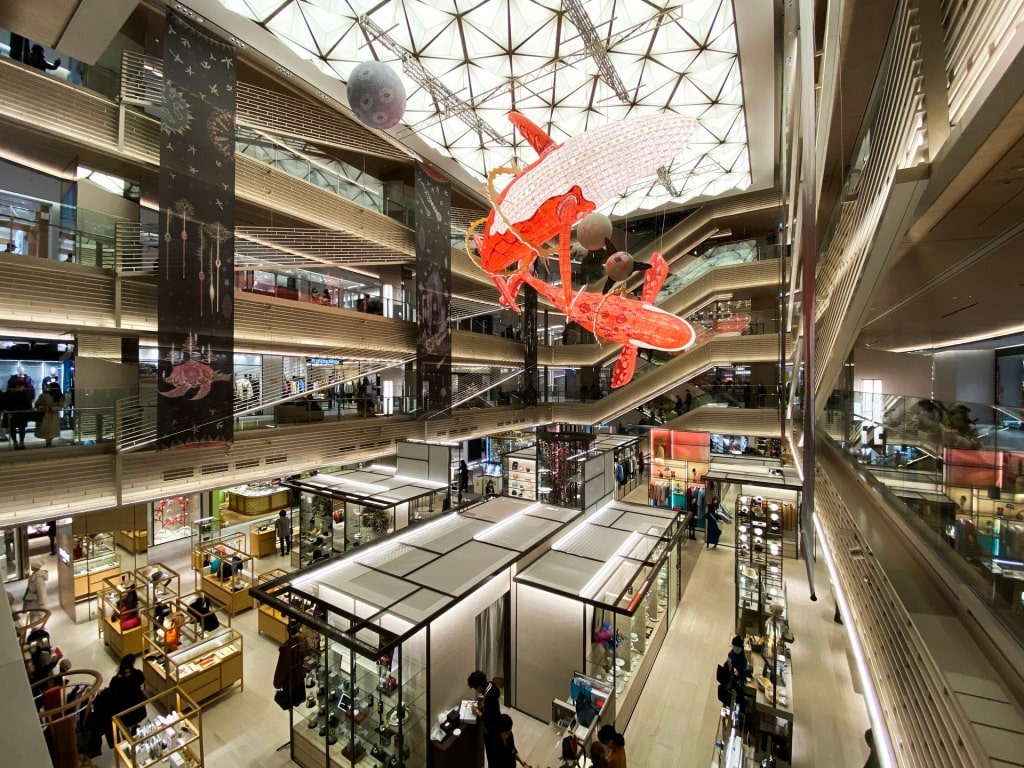
Ginza Six Photo by Wpcpey on Wikimedia Commons, licensed under CC BY 4.0
Ginza’s luxurious department stores include the striking Ginza Six, created by architect Yoshio Taniguchi, designer of NYC’s Museum of Modern Art. Inside, you can explore more than 200 shops that line floors inspired by the picturesque alleys of Kyoto and Ginza itself.
Ginza Six is the place to indulge yourself with Japan’s most avant-garde fashion designers, and the food hall in the basement is equally indulgent. For a break from shopping, relax in the rooftop garden, take in one of the regular modern art exhibitions or even visit the Noh theatre.
Elsewhere, the quirky Itoya supplies stationery in exquisite Japanese style, while the gigantic Mitsukoshi and Matsuya stores both offer a more traditional shopping experience.
Shibuya: Pedestrians & Youth
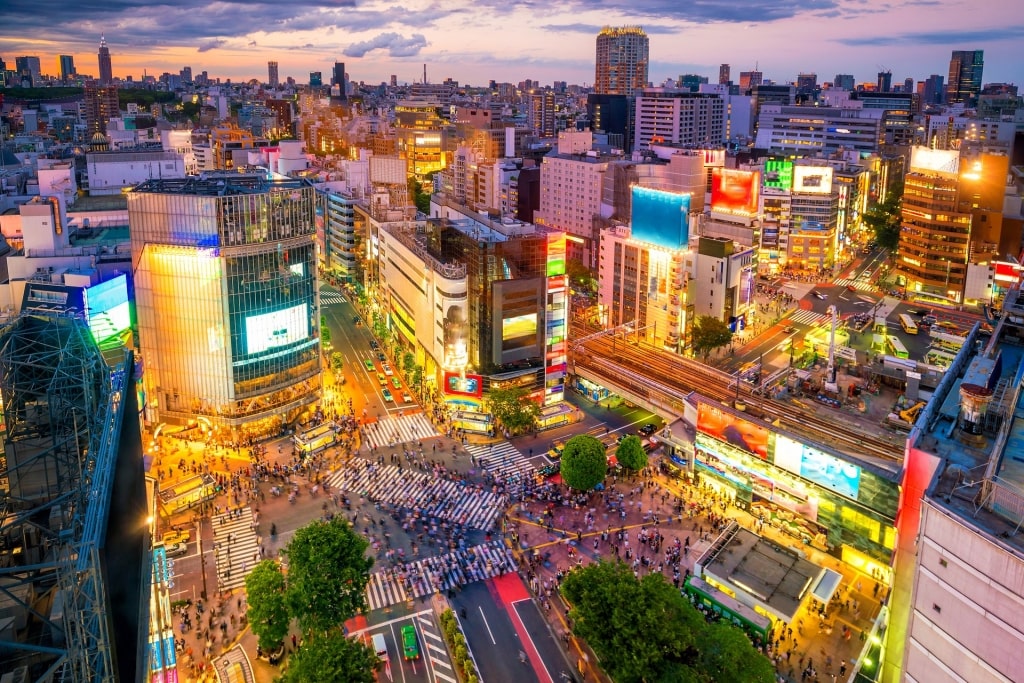
Shibuya
The pedestrian crosswalk outside Shibuya Station is the world’s most famous, with a constant, mesmerizing flow of people, immortalized in countless films and adverts. Up to 3,000 people cross at every light change. Why would you be one of the few visitors to Tokyo who can resist adding to the number?
Many of those crossing are the fashionable young people who are a photogenic feature of Shibuya and the neighboring Harajuku district. It is this pop culture of Shibuya that sets it apart from nearby Shinjuku.
In stores such as Shibuya’s Center Gai or Shibuya 109, a revolutionary concept by post-modern architect Minoru Takeyama, you’ll find the very latest trends in clothing, make-up and food. It’s a fascinating study into what we might all be wearing, or eating, in seasons to come.
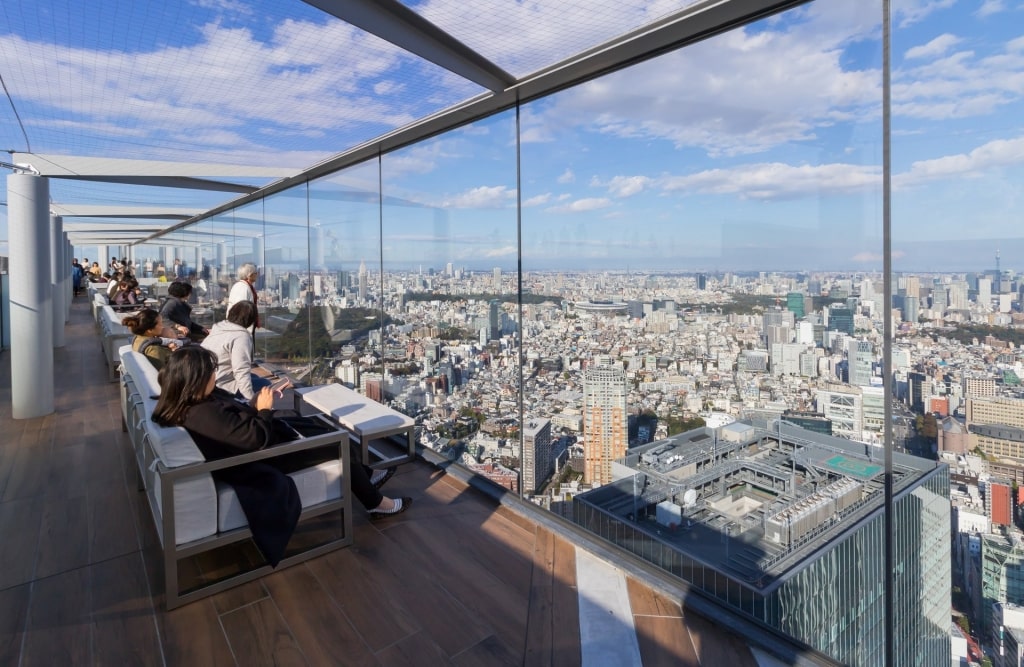
Shibuya Scramble Square Photo by Kakidai on Wikimedia Commons, licensed under CC BY 4.0
The 200 shops of Shibuya Scramble Square are another attraction and hard to pass by as you make your way to the rooftop “Shibuya Sky” observatory for a unique view of the famous crossing.
At night, the neon signage adds even more extra energy to the view and the many traditional Izakaya pubs lining the alleys of this Tokyo district are a wonderful cozy and human contrast to the towering skyscrapers all around.
One other very human touch is the famous statue of Hachikō, the loyal dog who still waited outside the station for almost a decade after his master died.
Read: What Is Japan Known For?
Shinjuku: Trains & Neon
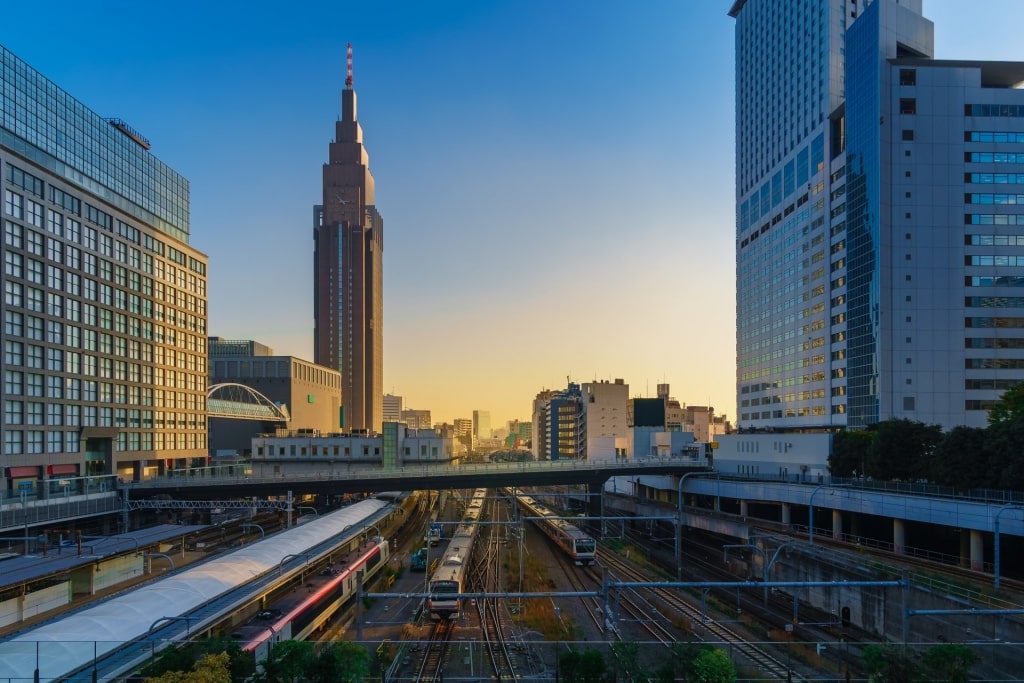
Shinjuku
Shinjuku is the busiest station in the world, with a mind-boggling 3.5 million people using its many train and bus lines every day. Even more amazing is how easy it is to navigate, a real tribute to Japanese efficiency and good manners.
The station is surrounded by hotels, restaurants and cafés to serve all those commuters and neighborhood workers. Walkways also lead directly to luxury department stores and palaces of the latest in technology.
Shinjuku is one of the very best places to buy a camera, phone or other electronic gadget that might be months or years ahead of coming to market anywhere else in the world.
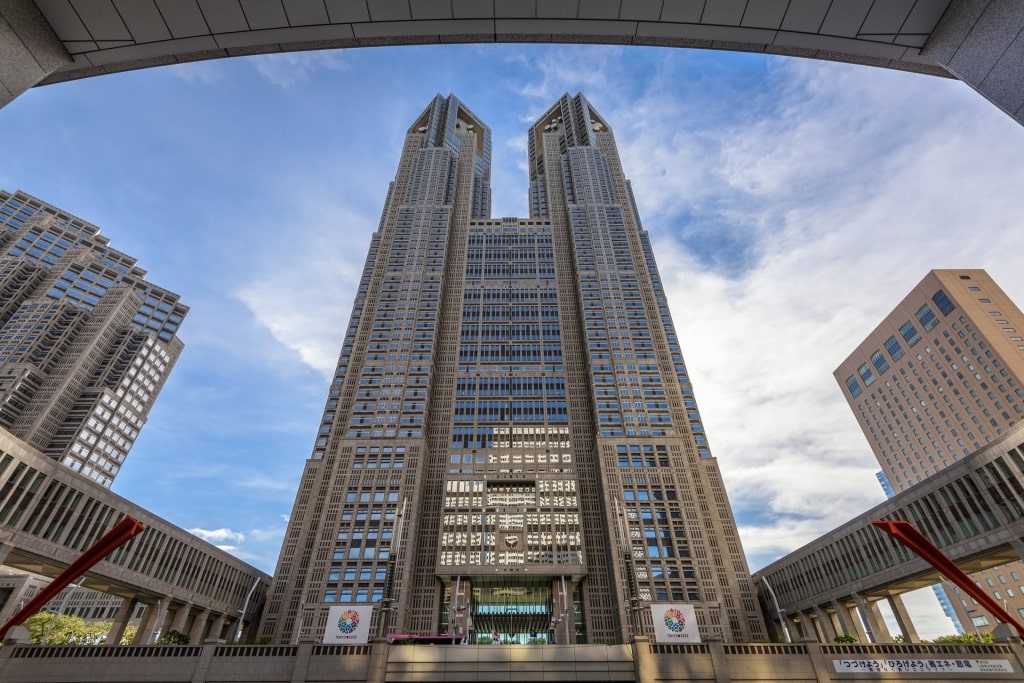
Tokyo Metropolitan Government Office Building, Shinjuku
You can take in amazing views of neon-lit canyons lined with modern skyscrapers from the 45th floor of the Tokyo Metropolitan Government Office Building. The second floor holds a tourist information center that can handle any queries about your visit to Japan.
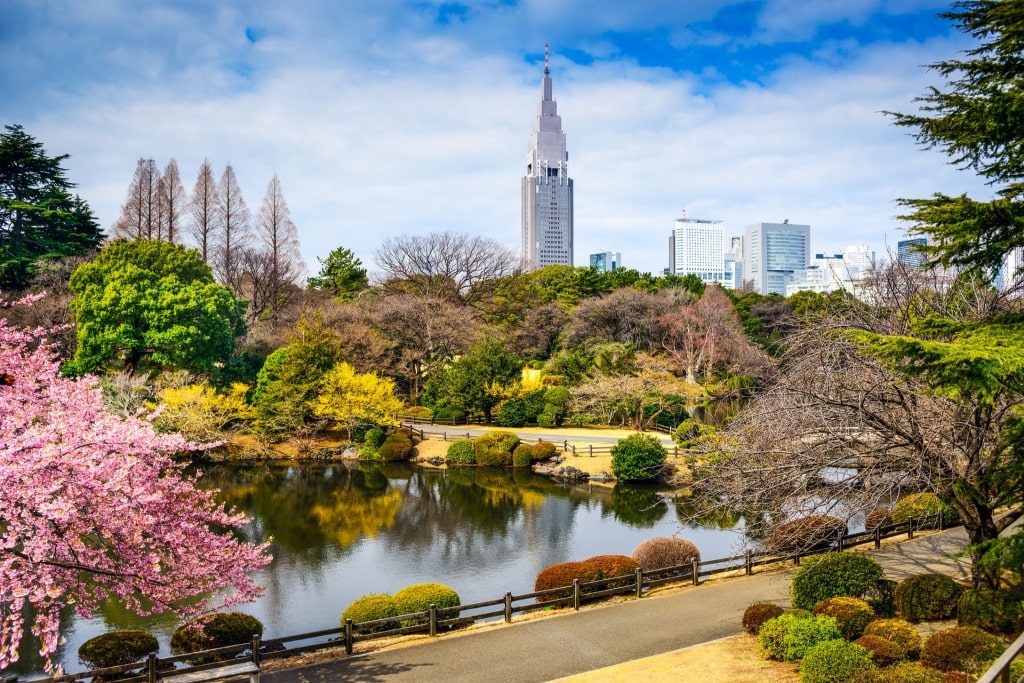
Shinjuku Gyoen Park
If you tire of shopping or sightseeing, find a haven of quiet in Shinjuku Gyoen Park, once an imperial (“gyoen”) garden. Its 20,000 trees include 1,500 cherry trees whose fragrant blossoms draw crowds of sightseers every spring.
Another refuge is the Sompo Museum of Art, home to a 200-strong collection of works by futurist Seiji Togo. It also holds Van Gogh’s “Sunflowers” as well as art from Cézanne, Gauguin, Renoir—and Grandma Moses.
At night, Shinjuku is a neon-lit wonderland, buzzing until well past midnight with hundreds of tiny Izakaya bars and restaurants of every style.
Tsukiji: Fish & Knives
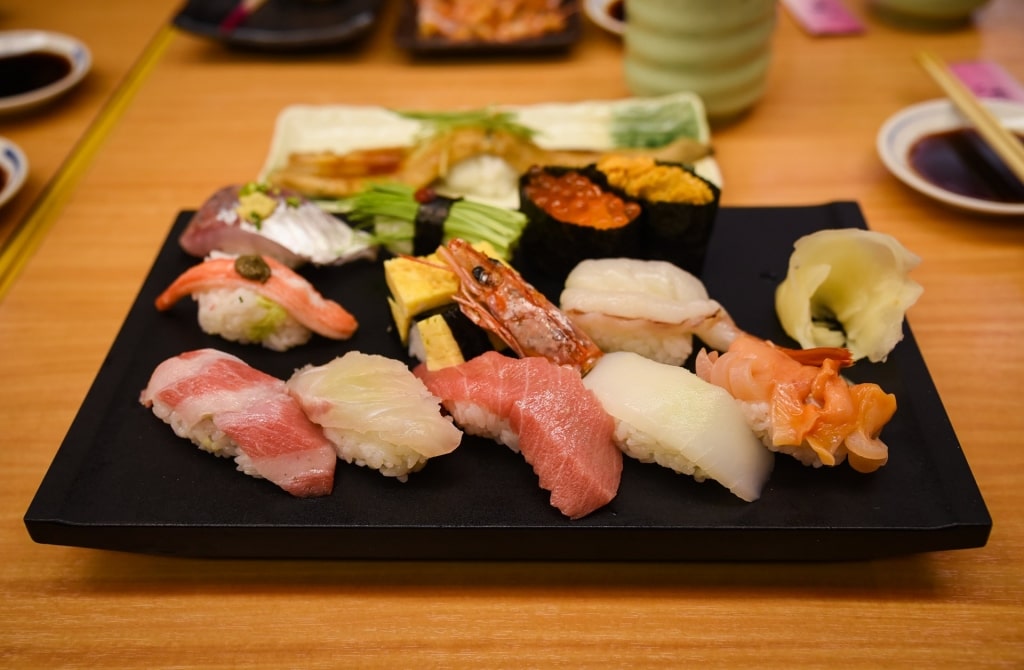
Tsukiji Market
Built on reclaimed marshland along the Sumida River during the 18th century, Tsukiji (“constructed land”) is famous as the site of Tokyo’s original fish market.
Stuck for space, the Central Market moved to a new site in 2018 but the historic old market remains the best place in Tokyo to eat amazing sushi and seafood.
A maze of small restaurants and cafés dotted among other culinary stores and food suppliers serve the busy market workers, so food is hearty, top quality and served fast. Sushi was once the traditional breakfast but there are plenty of other options you can sample all through the day.
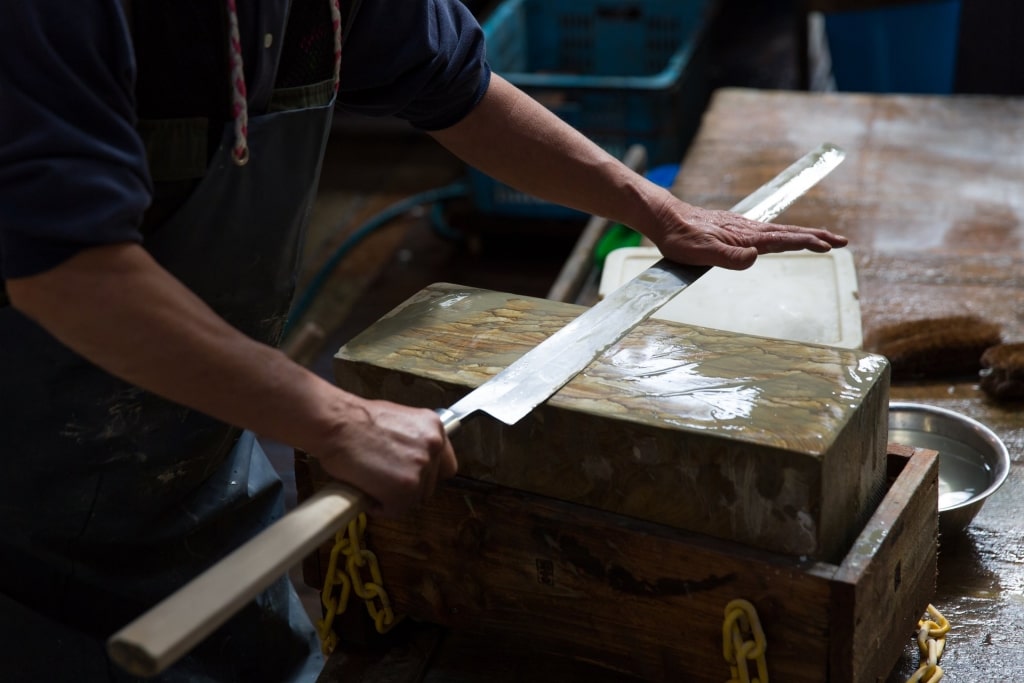
Tsukiji Market
If you’re not eating, you might still want to buy a set of razor-sharp knives, or just watch in wonder as a skilled worker puts their heart and soul into making perfect omelettes. If you’re a photographer, you could spend all day capturing the market, its people and its many colorful sights.
Tsukiji Hongan-ji is a Hindu-style Buddhist temple, much loved by market workers, that surprises with a flamboyant, gilded Japanese interior. Equally unexpected is its memorial to rock legend Hideto Matsumoto, a guitarist better known in the US by his stage name, “hide” [sic].
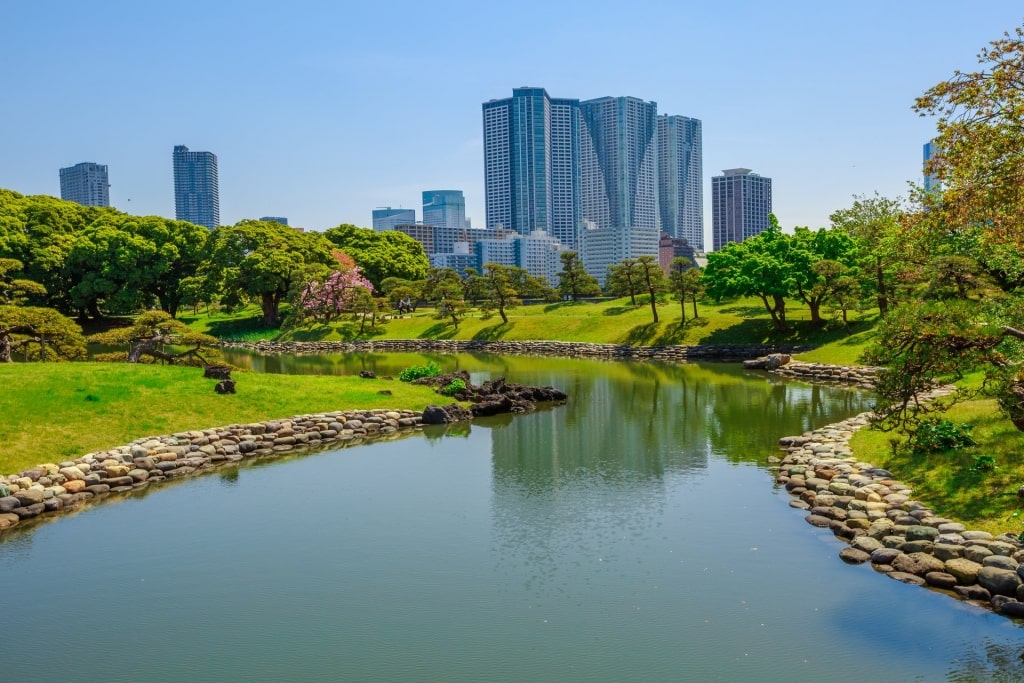
Hama-rikyu Gardens, Tsukiji
One of the most beautiful gardens in Tokyo, Hama-rikyu Gardens is another haven of peace, with tidal ponds and flower beds, and a truly lovely tea house. Laid out in the 1600s, its mature trees and city backdrop make for another photographer’s delight.
Read: What to Eat in Japan
Roppongi: Culture & Clubs
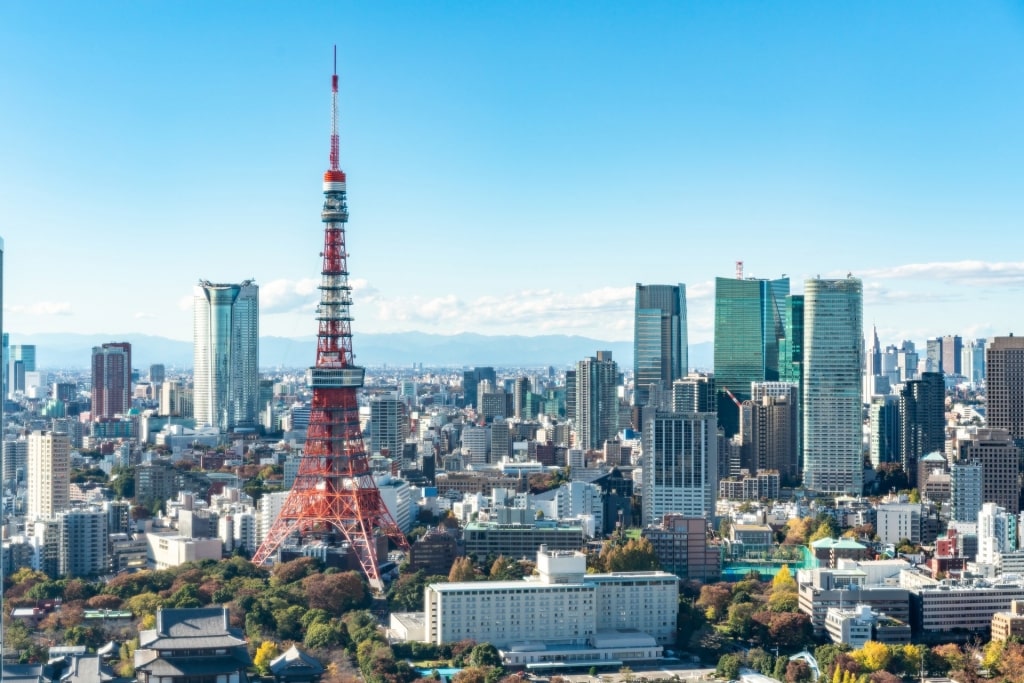
Roppongi
Roppongi’s use as a base for the Japanese army from the 1890, and the US Army from the 1950s, have given this Tokyo district a reputation for crazy nightlife—and more. It still remains popular with foreigners for its clubs and bars but has been transformed in recent years into a major upmarket shopping, hotel, residential and cultural space.
Central to that was the Roppongi Hills development of offices, apartments, shops, restaurants, and the Mori Art Museum housed in the 54-story More Tower. Its outdoor Sky Deck delivers some of the best views of Tokyo you’ll find.
A few years later, in 2007, Roppongi Hills was joined by Tokyo Midtown with a similar mix of housing, retail and entertainment. As well as the Ritz-Carlton Tokyo, whose 53rd-floor Ritz-Carlton Suite is one of the world’s most expensive, the complex also holds the Suntory Museum of Art.
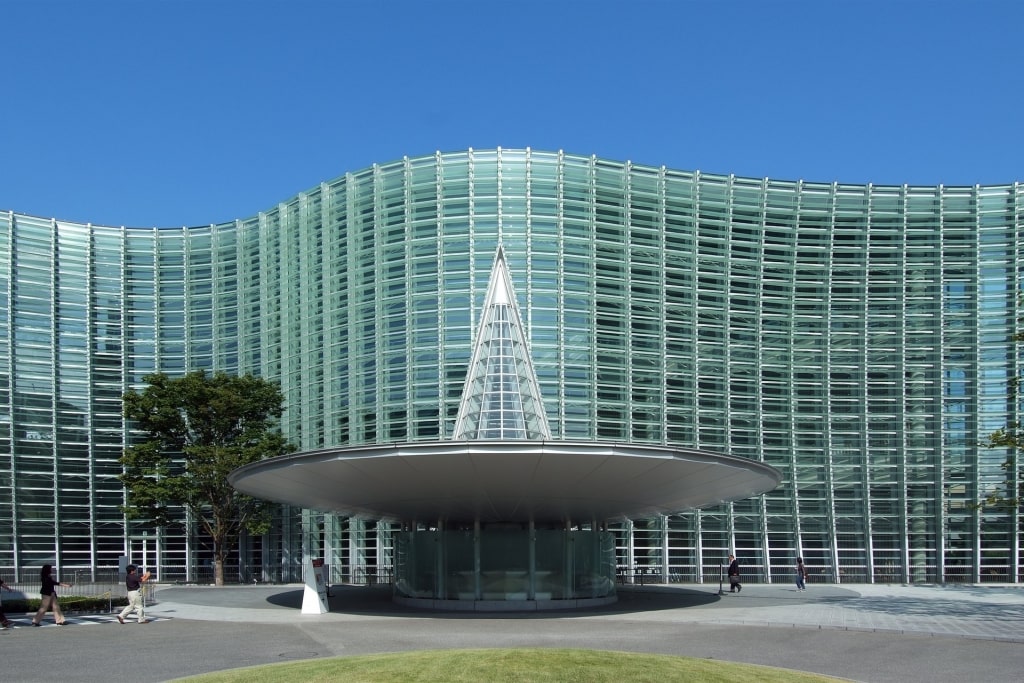
National Art Center, Roppongi Photo by Wiiii on Wikimedia Commons, licensed under CC BY-SA 2.0
A short walk from Roppongi Hills is the huge National Art Center, Japan’s largest—and many say its best—art museum. Although having no permanent art collection of its own, you can see special, beautifully curated exhibitions showing art from Japan and around the world.
The twin 54-story towers of Midtown and Roppongi Hills stand a 20-minute walk apart and act as beacons attracting the best in high-end retail and Michelin-star restaurants to the neighborhood. If you need a break from the sometimes overwhelming sensory thrill of being in Tokyo, all are among the most foreigner-friendly experiences in Tokyo.
Omotesando: See & Be Seen
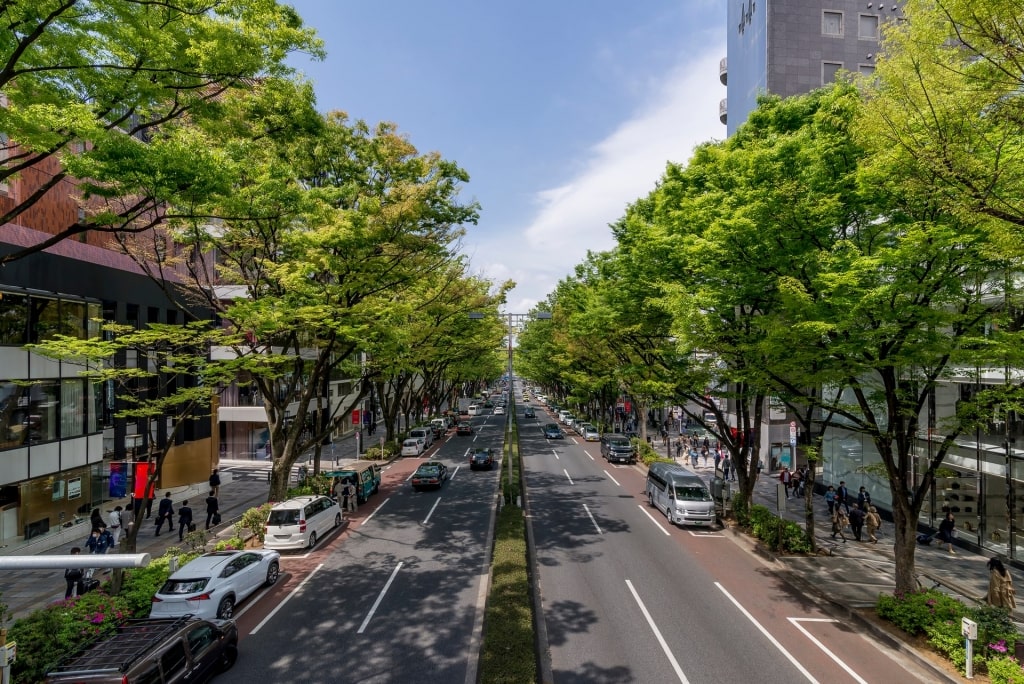
Omotesando
Omotesando is an avenue that has grown from the main approach road to the Meiji Shrine into a premier shopping destination, the so-called “Champs-Elysees of Tokyo”. Like its Parisian cousin, it’s the place to shop, stroll, see and be seen.
Also like its French counterpart, Omotesando is lined with trees, whose shade in summer and bare branches in winter are reflected in the seasonal changes of its fashion stores. These boast collections from designer names such as Louis Vuitton, Versace, Gucci, Prada, Dior and, of course, Comme des Garçons and Issey Miyake.
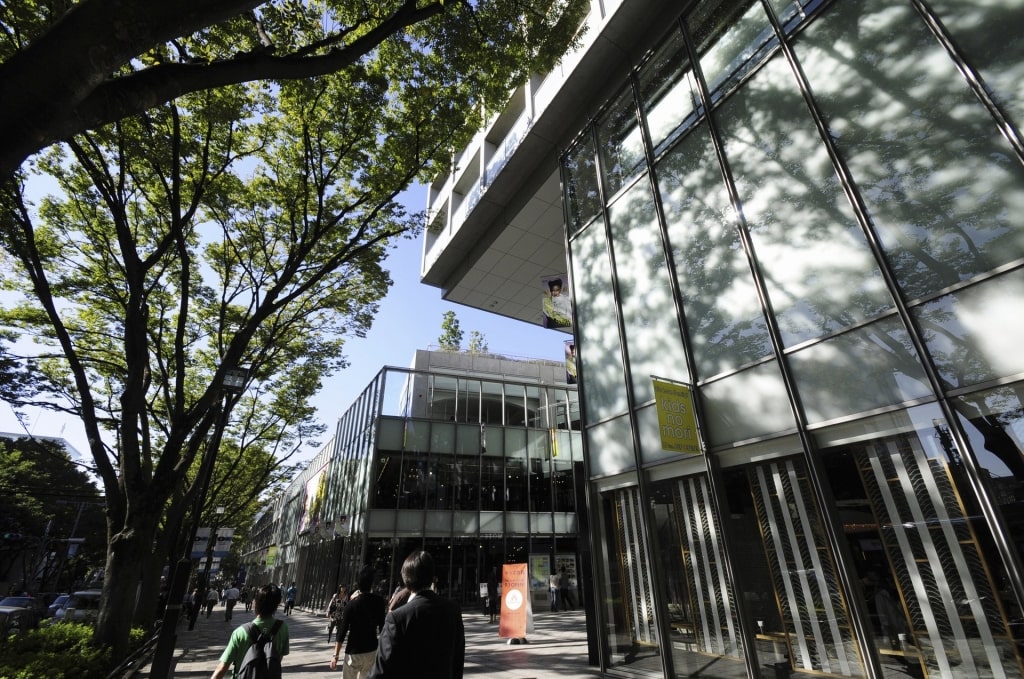
Omotesando Hills
The stores themselves are by a glittering array of Japanese and foreign architects, with Tadao Ando’s Omotesando Hills complex among the most popular. This 12-story shopping centre—half below ground—is where to go if you’re looking for the likes of Jimmy Choo, Yohji Yamamoto or Jun Hashimoto.
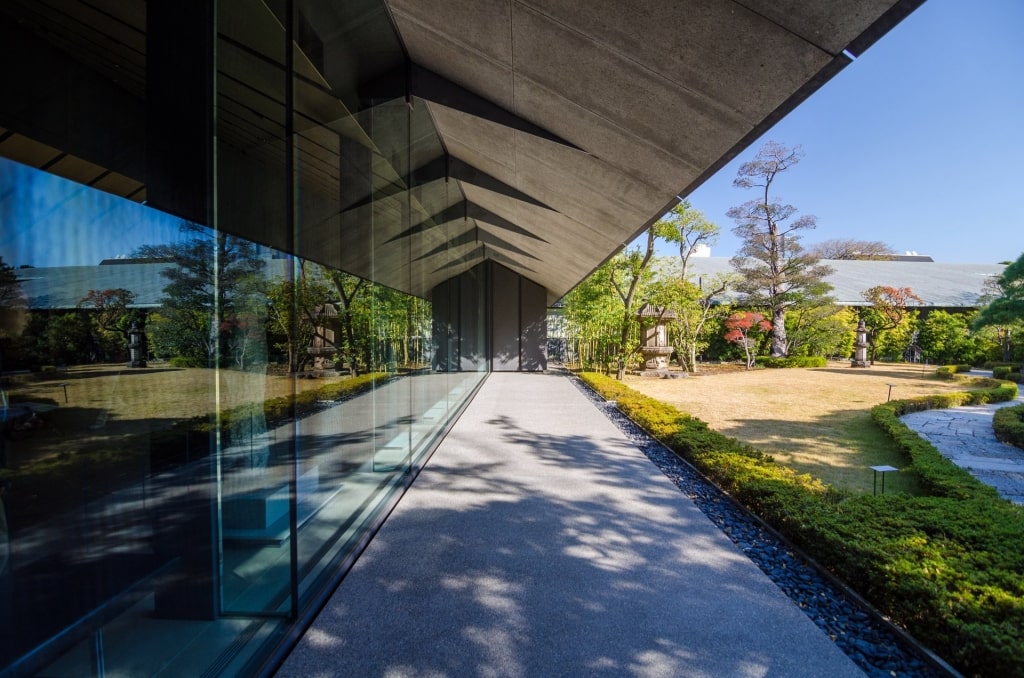
Nezu Museum, Omotesando
On another part of the art spectrum are the Watari Museum of Contemporary Art and the Nezu Museum, filled with pre-modern Japanese and East Asian art. The Taro Okamoto Museum was the avant-garde artist’s home and studio for 42 years and is filled with many colorful works.
The narrow side roads of Cat Street and Ura-Harajuku are places to see living art in the form of hip boutiques and young pedestrians sporting high fashion. Stroll around, taking in the sights and perhaps taking a break in one of the numerous cafés to soak up the atmosphere of this exclusive neighborhood.
Akihabara: Tech & Manga
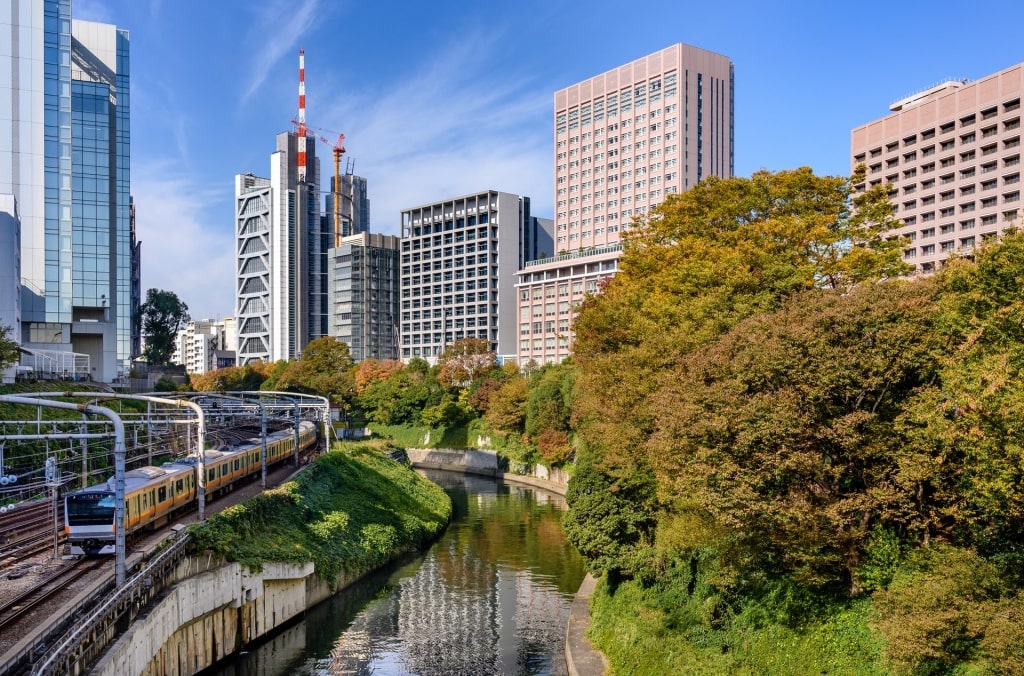
Akihabara
With an edgy past as a post-war black market in electronic parts, Akihabara still thrives on its counter-culture vibes. Nowadays, however, that mostly involves posing as a character from manga or anime.
Manga are comic books or graphic novels in a distinctive colorful style, while anime—a loan word based on the English word “animation”—refers to similar cartoon-style movies or TV shows. Passionate fans, especially those who love dressing up in costume, are referred to as “otaku” and Akihabara is their spiritual home.
Stroll around this neighborhood in Tokyo and you’ll see hundreds of stores dedicated to niche specialities of the style, while the streets are thronged with otaku in equally diverse costumes. Partly serious, partly fun, it’s hard not to get swept up in the enthusiasm and it’s certainly a unique experience as well as a photographer’s delight.
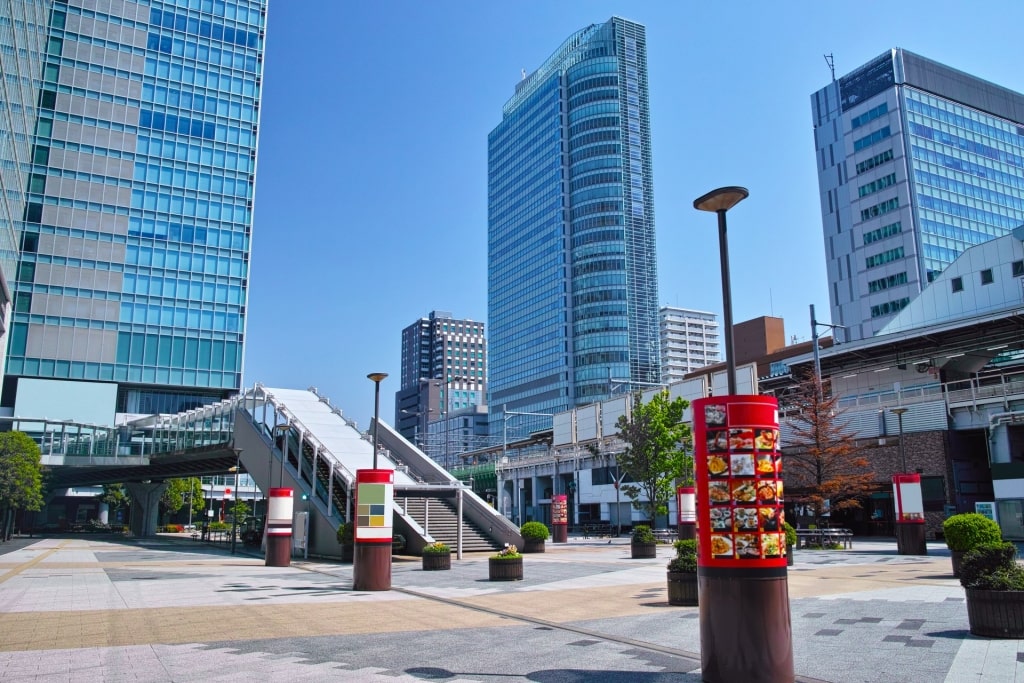
Akihabara
Akihabara—or “Electric Town”, as it is nicknamed—is also a vast showroom for the very latest in Japanese technology, with stores specializing in every major brand and product. Duty-free shopping for visitors means you might struggle to resist the temptation to snap up a bargain camera or clever gadget.
Amid this ultramodern Japan, it’s a surprise to find the 2k540 Aki-Oka Artisan arcade beneath the JR Yamanote Line track. Here, 50 different shops focus on unique arts and crafts such as pottery and textiles from all across Japan, handmade articles you might find nowhere else in Tokyo.
Ebisu: Beer & Greenery
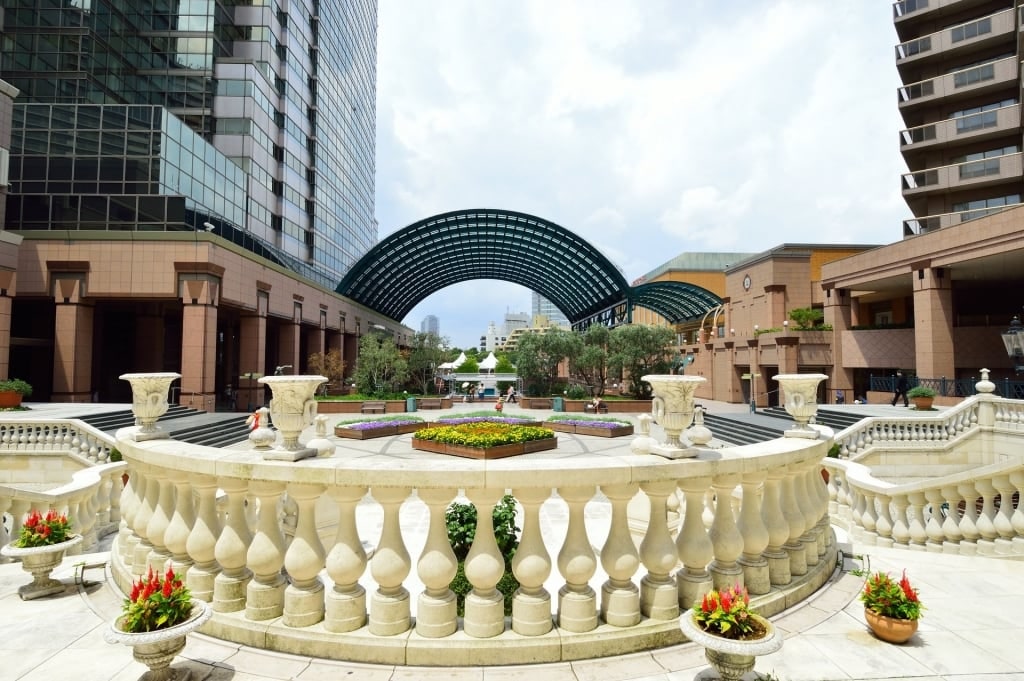
Yebisu Garden, Ebisu
One of the most desirable residential neighborhoods in Tokyo, Ebisu is a haven of green spaces and outdoor cafés. Here you can see a different, quieter side to Tokyo than its energetic center.
This is the place to linger over a wonderful meal, or take your time choosing a new jacket in one of Ebisu’s many stylish shops. It’s within Shibuya Ward but very different from the buzzing Shibuya neighborhood itself.
Start in Yebisu Garden, the park around the former brewery whose beer (now rebranded as Sapporo) gave its name to the neighborhood. Discover more in the Museum of Yebisu Beer or just enjoy the shops, restaurants or Mitsukoshi department store within Yebisu Garden Place.
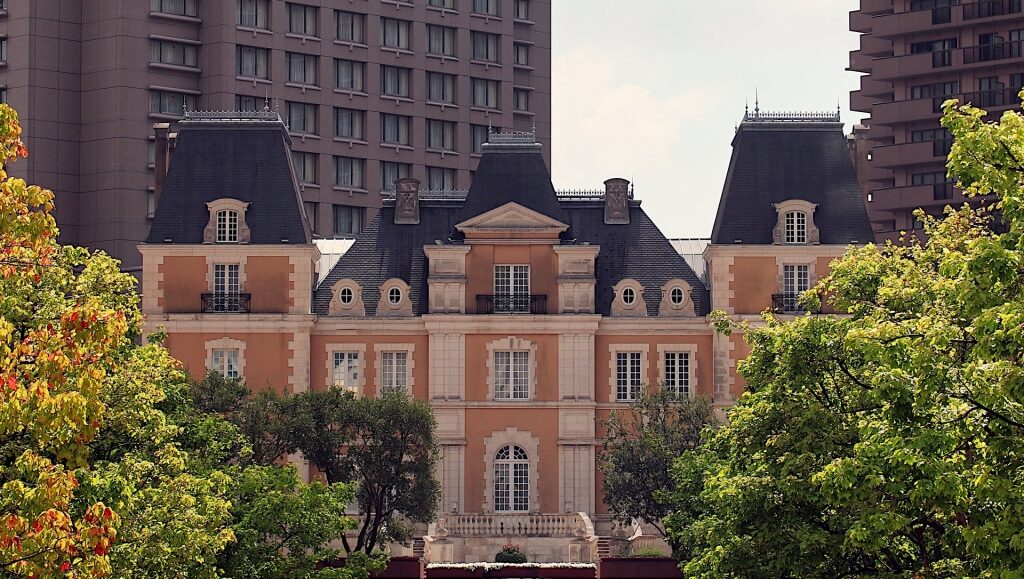
Joël Robuchon Restaurant, Ebisu
A French-style “chateau” at one end of the garden is home to Joel Robuchon Restaurant, a Michelin three-star experience. Beside it is the Westin Hotel, whose lounge is the perfect place for a leisurely afternoon tea.
The Tokyo Photographic Art Museum (TOP) is also a must-see if you have an interest in photography. It holds a large collection of images from Japanese and other photographers, and the museum shop is perfect for unusual gifts and cards.
Ebisu is full of cozy restaurants as well as izakaya pubs and tachinomiya (“stand up and drink”) bars. These latter are exactly as described in their name and they really add character to this area’s special atmosphere.
Odaiba: Water & Lights
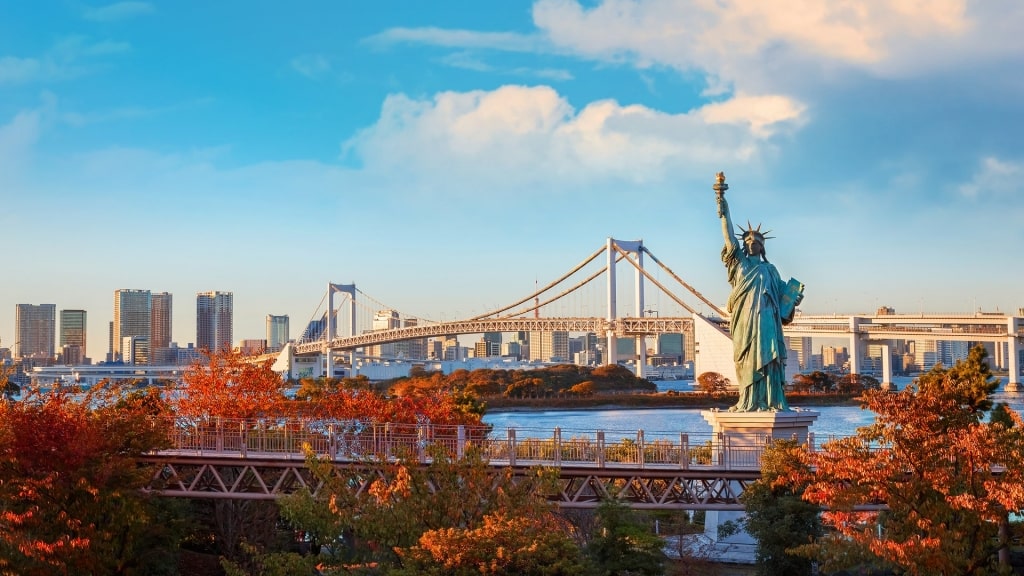
Odaiba
The best way to describe Odaiba is like a Shinjuku by the sea. That doesn’t really do justice to its buzzing mix of high-tech shopping and family fun amid green space and futuristic architecture that make it one of the most beautiful places in Japan.
Odaiba is an artificial island in Tokyo Bay, originally built in the 19th century for defense (Odaiba means “fort”) and much expanded during the property boom of the 1980s. It is connected to the mainland by the striking two-story multicolored Rainbow Bridge.
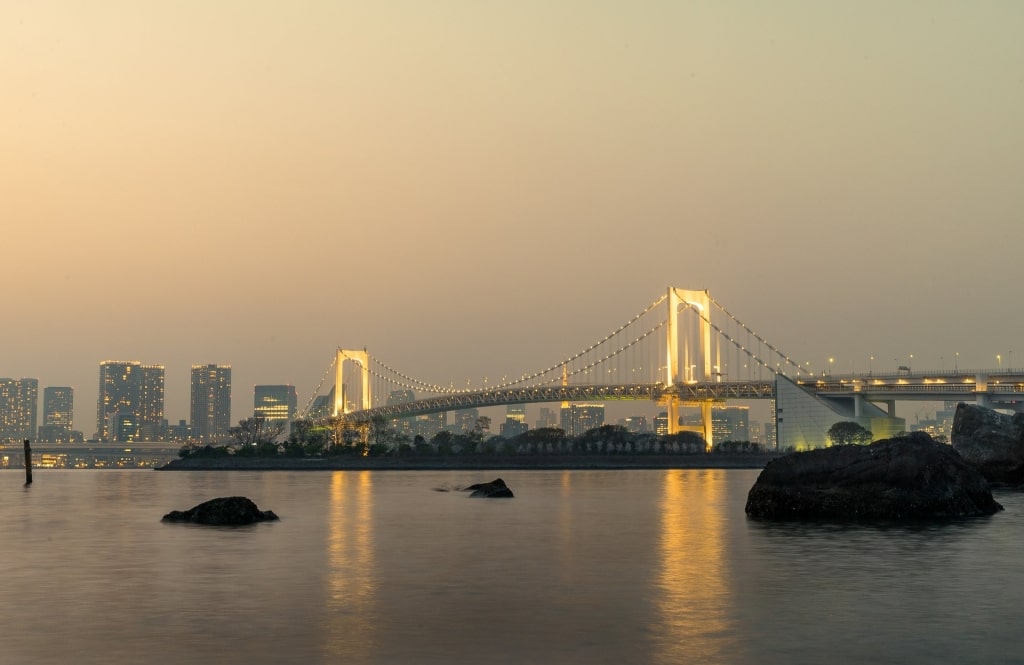
Odaiba
Take a water-bus tour or the futuristic Yurikamome elevated train running over the bridge—beautifully lit at night—to get your bearings and enjoy fantastic views of Tokyo. Fully automated, the train has a station at the Tokyo International Cruise Terminal on Odaiba.
Nearby is the National Museum of Emerging Science and Innovation (Miraikan), a must-see science museum in Tokyo. This bilingual science museum has plenty of fascinating exhibits for you to interact with and is well known for its robots.
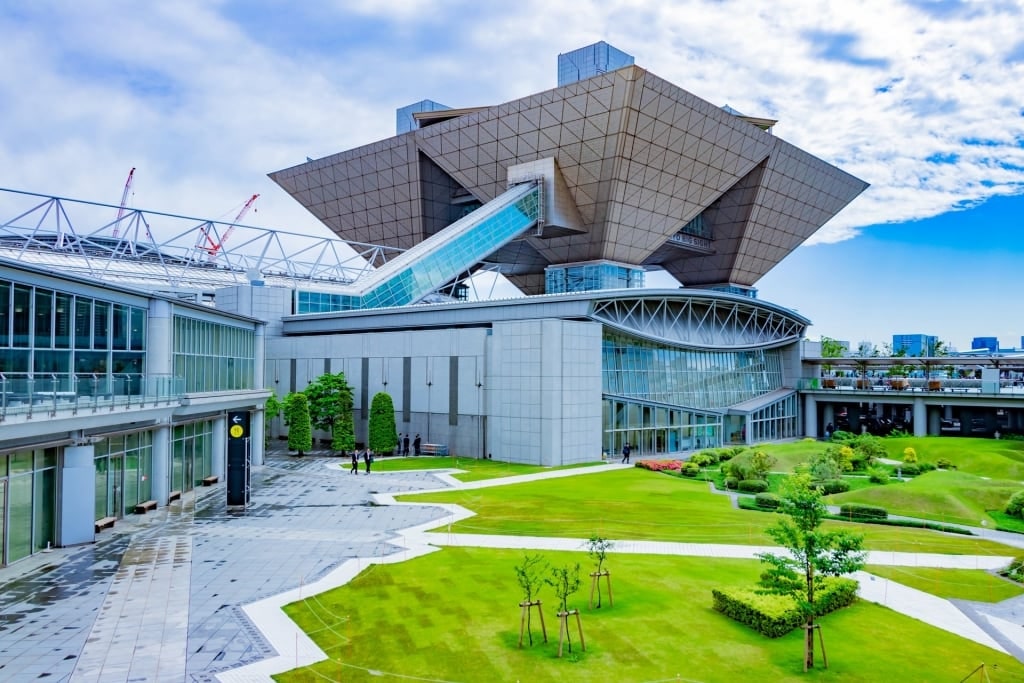
Tokyo Big Sight, Odaiba
Tech companies Panasonic and Fuji also have their own showrooms in this Tokyo neighborhood where you can buy products or just get a glimpse of what the future will hold. Tokyo Big Sight, the Tokyo International Exhibition Center, regularly hosts major events including the Tokyo Motor Show.
Shopping complexes include AQUA CiTY, offering 140 shops, and DiverCity Tokyo Plaza, with a giant Gundam robot outside. If you are a cat-lover, you will really want to see Cats Livin, a store purr-fect for anything feline-related.
How many neighborhoods are there in Tokyo?
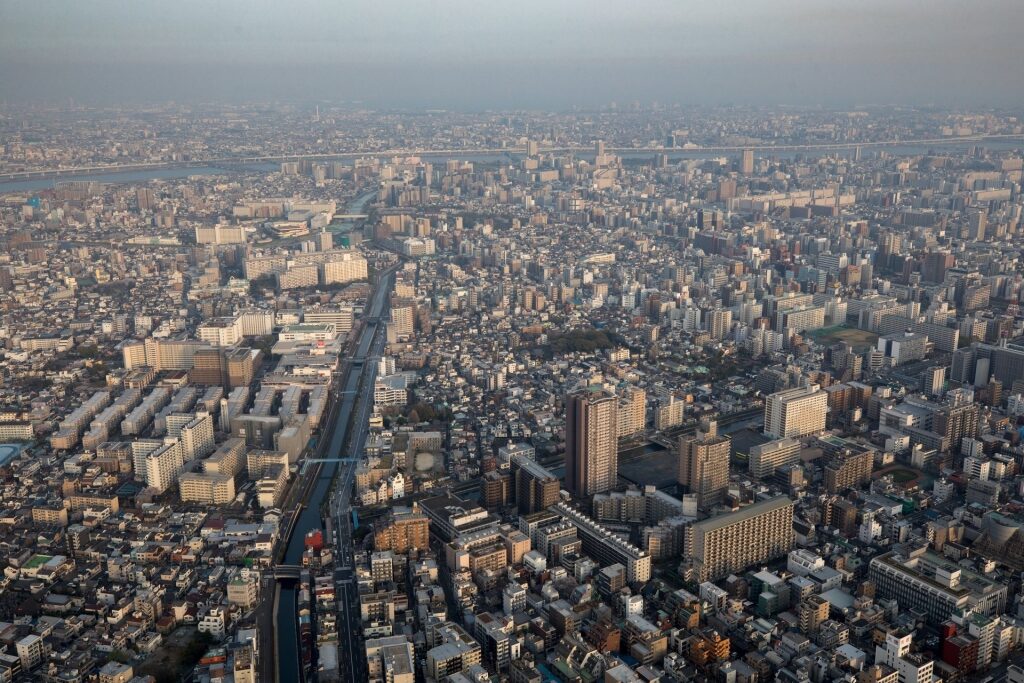
Like any large metropolis, Tokyo has swallowed up other small cities, towns and villages. They are all now governed through division into 23 city wards, five of which make up Central Tokyo. Each ward refers to itself as a city, such as Shibuya City, Shinjuku City or Minato City.
What are the neighborhoods in Tokyo called?
Metropolitan Tokyo’s wards are split further into many smaller neighborhoods defined by the nearest train or metro station, of which there are 1,000. So the neighborhood (“go kinjo”) known as Shinjuku is the vibrant district around Shinjuku station, both of which spill over into Shibuya ward.
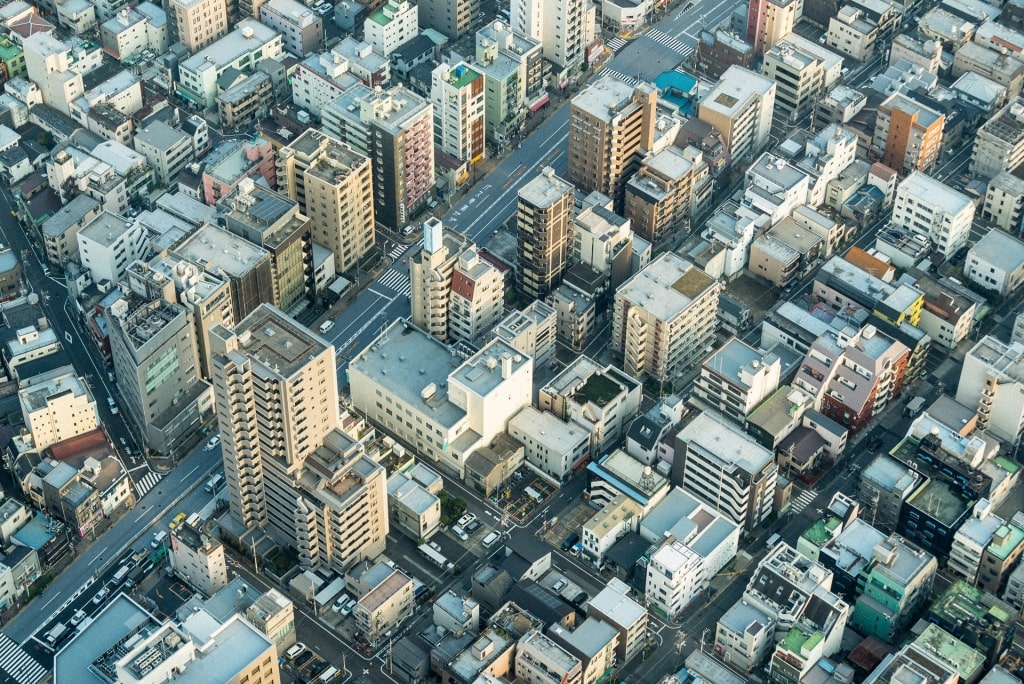
Tokyo
Inspired by this fascinating, eclectic city? Browse our cruises to Japan and start planning your vacation to Tokyo today.
